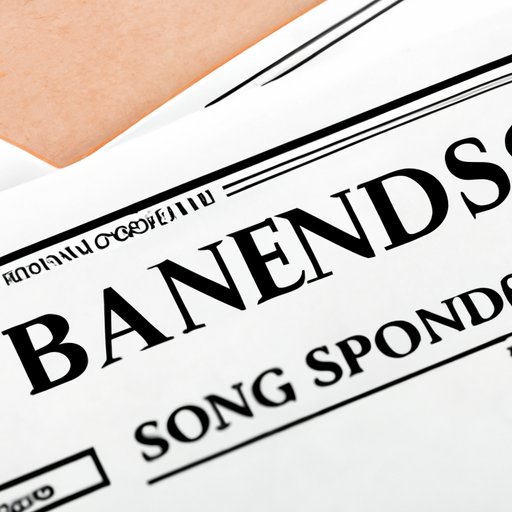
I. Introduction
Savings bonds have been a popular investment tool for generations. They are typically considered a secure investment with low risk, making them a popular choice among conservative investors. However, in certain situations, cashing a savings bond may be necessary. In this article, we will explore how to cash a savings bond, including common mistakes to avoid, tax implications, and alternatives.
II. Step-by-Step Guide: How to Cash a Savings Bond
Before cashing a savings bond, it is essential to understand the different types of bonds, their redemption rules, and maturity date. Redemption rules vary based on the type of bond, and it is crucial to confirm the rules before cashing them.
The process of cashing a savings bond may seem straightforward, but it is essential to follow the instructions carefully to avoid mistakes. Here are the steps:
1. Checking the bond’s value and maturity date
Before cashing a bond, check for its current value and maturity date. You can refer to the Treasury Direct website or use the Savings Bond Calculator to determine the bond’s current value. You can also find its maturity date on the bond.
2. Filling out and signing the necessary forms
To cash a savings bond, you will need to fill out and sign the necessary forms. These forms can typically be found at your bank or financial institution. Be sure to fill out the forms correctly and double-check all information before submitting.
3. Providing identification
To cash a savings bond, you will need to provide valid, government-issued identification, such as a driver’s license or passport. Make sure to have the appropriate identification to avoid delays or rejections.
4. Submitting the bond to a bank or financial institution for cashing
After completing the forms and providing identification, submit the bond to a bank or financial institution for cashing. You will typically receive the cash value of the bond on the spot.

III. Common Mistakes to Avoid When Cashing Savings Bonds
Cashing savings bonds can be a simple process, but many people make common mistakes that can cause delays or even rejection. Here are some of the most common mistakes to avoid:
1. Not having the necessary identification or paperwork
Before heading to the bank or financial institution, always double-check that you have all the necessary identification and paperwork. This includes valid identification and the correct forms needed to cash the bond.
2. Not endorsing the bond properly
Endorsing a savings bond correctly is critical to ensure that the financial institution can process the bond. Make sure to sign the bond according to the instructions before submitting it for cashing.
3. Filling out the form incorrectly
Filling out forms incorrectly can cause delays or even rejection of the bond. Be sure to read the instructions carefully and double-check all information before submitting the bond.
IV. Explaining the Process of Cashing a Savings Bond
After submitting a savings bond, it undergoes a redemption process, which includes processing by banks, financial institutions, and the Treasury department. During this process, the bank or financial institution sends the bond to the Federal Reserve, which transfers the funds to the Treasury department.
The Treasury department then verifies the bond’s information and sends the redemption payment to the financial institution’s account. This entire process usually takes around two weeks to receive the cash value of the bond.
V. Benefits and Drawbacks of Cashing Savings Bonds
Before cashing a savings bond, it is essential to consider the potential benefits and drawbacks. Some of the benefits include having cash in hand, investing the cash elsewhere, and avoiding early redemption penalties. However, cashing a savings bond can also have drawbacks, such as owing taxes on the redeemed value, missing out on future earnings from the bond, and potential penalties for cashing the bond too early.
VI. Tax Implications of Cashing Savings Bonds
Cashing a savings bond can have tax implications. The interest earned on savings bonds is typically taxed at the federal level, but not at the state or local level. Additionally, if you cash a savings bond before maturity, you may be subject to additional taxes.
It is also essential to know when and how to report redeemed savings bonds on your tax return. You can check the Treasury website or speak to a tax professional for more information on the tax implications of cashing a savings bond.
VII. Alternatives to Cashing Savings Bonds
If you’re not ready to cash your savings bond, there are other ways to use it without redeeming it. For example, you can use it to pay for education expenses, continue to hold onto it as an investment, or pass it on as an inheritance.
VIII. Frequently Asked Questions About Cashing Savings Bonds
Here are some of the most frequently asked questions about cashing savings bonds:
1. Who can cash a savings bond?
Savings bonds can be cashed by the owner of the bond or a co-owner.
2. How long does it take to receive the cash value of a bond?
The entire process of cashing a savings bond usually takes around two weeks.
3. What should I do if a savings bond is lost or stolen?
If your savings bond is lost or stolen, you can file a claim with the Treasury’s Bureau of the Fiscal Service to have it reissued.
IX. Conclusion
In conclusion, cashing a savings bond can be a simple process if you follow the right steps. It is also essential to understand the potential tax implications and alternatives before redeeming your savings bond. We hope this guide has helped you understand how to cash a savings bond and answered any questions you may have.




